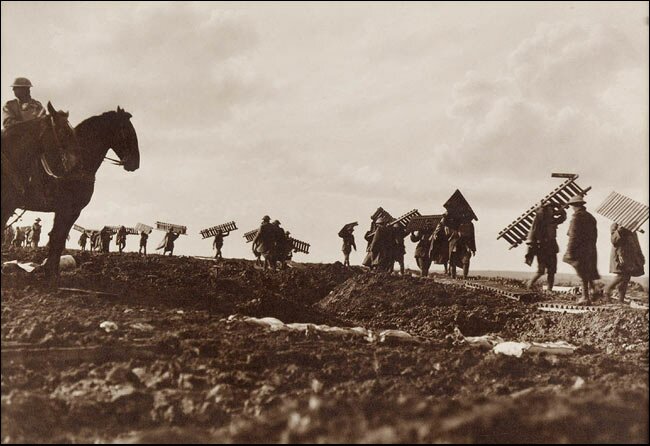
(As you can see I've amalgamated May and June 1917. After doing research I found that June was another quiet month for the battalion, with very few military actions.)
The 123rd Pioneer Battalion began May 1917 with 1264 men and 46 officers. The first day of May began with an explosion of an old French ammunition dump. The cause of the explosion was never found and there were four casualties.
"D" company was put to work repairing the road around La Targette. On May 5th another ammunition dump exploded, this time a gas alert was issued. Again, the cause was never found.
Compared with the excitement of the Vimy Ridge offensive, May 1917, was quiet. The four companies of the battalion were soon taken off road work and sent to the trenches at Vimy Ridge, for repair detail. The 123rd up until this time had been billeted in tents near the front lines and never had experienced trench warfare before. Now the men were billeted in chalk pits, which the OC assured, were "shell proof."
Deward Barnes of the 19th Battalion, which was part of the assault on Vimy Ridge and was still on the front lines, wrote about the conditions in the trenches.
"The shelling was terrible. It was really heavy now as we got the whiz bangs. And he certainly could send them fast."
(It Made You Think Of Home, page 78.)
The maintenance work the 123rd would have been involved in would have been laying new duckboards, repairing communications lines, digging new trench systems, repairing siding, pipe lines, etc.
"A" Company was tasked with grading and excavating the woods near Vimy. Since arriving in the woods, "A' Company was shelled daily and gassed. On May 12th "A" Company was pulled out from Farbus Woods. In ten days they had suffered thirty causalities. "D" Company relieved them.
On May 16th, news was received that the 3rd Pioneer Battalion was being disbanded and the men were going to be divided up between all the other Pioneer Battalions. The 123rd received 42 men.
As I mentioned before, May 1917 was a quiet month. Even the War Diary of the 123rd attests to this. The end of May saw the Battalion engage in a number of recreational activities. On May 24th the regimental baseball team played the 107th Pioneers, beating them 20 to 1. On May 25th "D" Company was relieved by "C" Company and sent to work with the 1st and 3rd Army Troops Company. May ended with the Battalion moving to a new camp.
June
After the relatively quiet month of May, June 1917 started off with the 4th Canadian Division carrying out a heavy artillery bombardment around the area of La Targette. Aerial bombardment by German planes continued during the nights, but no causalities were recorded. D Company, which numbered 100, was sent to work on road repair while the other three companies rested, built trenches or worked on railways.
On June 10th, the Battalion received word that two men Pte. James Hillis and Cpl. John Morrison were to be awarded the Military Medal for bravery. They are the first (but not the last) to receive a medal for bravery. Two days later, the Canadian Corps was informed that Sir Julian Byng was to be leaving as commander. General Byng had commanded the Canadian Corps since 1916. With Arthur Currie, he commanded the Canadian Corps when they took Vimy. Soldiers called themselves, "Byng's Boys" and he remained a popular figure in Canada (Byng was made Governor General in 1921.)

By mid month, the Battalion had moved up again to the trenches at Vimy to do more repair work. On June 23rd, the CO, Major Brown and Lt. Galbraith spent the early morning going over plans for an upcoming operation the battalion was to be involved in. On the night of the 27th, 200 men from the battalion were sent to work on the communications trench, while the Infantry engaged in operations. Working through the night, under shell and machine gun fire, they were able to finish the trench. In the morning, the Infantry ordered them to cease work, afraid that they would draw fire.
On June 27th, the Battalion was ordered to rest for 10 days. This didn't last. That afternoon, the CO was told that the 9th Infantry Brigade had been ordered to capture Avion trench. The 123rd was ordered to field 200 men to construct a communications and fire trench on the right flank of the objective. They were also ordered to consolidate Avion Trench when it was taken. The CO was to have none of this. After storming up to division headquarters, it was decided that if the 9th Infantry Brigade wanted Avion Trench consolidated, they were going to have to do it themselves.

This reprieve didn't last long. At the end of the month the battalion was ordered, again, to field 200 men to build 400 yards of communications trench. The work wasn't successful due to muddy and wet conditions. There were three casualties due to accidents.

(the pictures were taken by photographer Frank Hurley)





No comments:
Post a Comment